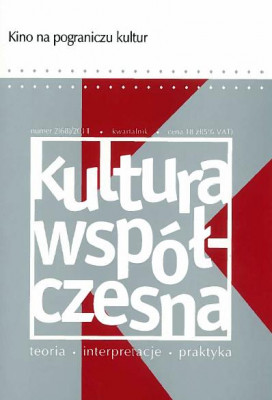Settings and search
Kino na pograniczu kultur


In the 1970s and 1980s the cinema of national minorities in Germany concentrated on the life and work of Turkish workers (Gastarbeiterkino). At the turn of 1990s there emerged films depicting the life of the second generation of Turkish immigrants – young people already born in Germany. The youngest generation of film directors, who begun their career in the 1990s, contrarily attempts to question the negative image of Turkish minority, going over the schematic image of socially and culturally handicapped immigrant. On the one hand, a new phenomenon is the change of poetics (departure from documentary convention), on the other – allusions to contemporary theories of culture, e.g. gender studies.
Situated at the peripheries of Europe, Lapland and the Sami people have been a cinematic theme since the second half of the 1980s. The cultural borderland emerges in these films on the one hand through the allusions to traditional culture, on the other – through the reference to the 20th century conflicts in the territories inhabited by the people who belong to different cultures. The cinematic trend interested in the themes of the culture of the Sami people was initiated by Nils Gaup. The artist who undertakes the problems of the involvement of ethnic identities and the images of the Other in the global military conflict is Aleksander Rogoz˙kin. Misunderstandings caused by multicultural character of the context are neutralised by the reference to a pre-linguistic, corporeal level of communication. Lapland as the cultural borderland is being treated from time to time as a utopian space of refuge from civilisation’s threats into a world of basic existential values which emerge due to the raw nature (Peter Lichfeld).
Shot in 1990 In the Middle of Europe, a film by Piotr Łazarkiewicz, is an adaptation of a short story by Bogdan Madej Jews, Tartars and Others. The director created a very true and honest image of the town community after world war II. Before the war this community was very well functioning conglomeration of various cultures and religions: Christians, Jews and Muslims. After the war a return to the former state of matters turned out to be impossible. Very few Jewish inhabitants of the town who had managed to survived, shortly after the return to their homes were murdered by their former neighbours, Poles and Tartars. The motive of the crime was mostly unwillingness to give back the Jewish goods and belongings. In the Middle of Europe is the only film in Polish cinema which depicts the pogrom the the Jews. Łazarkiewicz forces his viewers to confront the image incommensurate with the vision of the war and postwar times promoted by the cinema during the times of the People’s Republic of Poland. He also posed a question concerning a very specific status of the Jews in Polish culture, the power of anti-Semitic stereotype and situations in which it has been activated.
Protagonists of James Ivory’s films usually live in times of an important cultural change, they witness clashing visions of reality and the discrepancy between past and present. The conflicts of cultures and their overcoming are being depicted, among other things, in the melodramatic convention. By doing so the director poses a question concerning the universality of the particular values and attitudes, e.g. love. A romantic history becomes here also a pretext for the depiction of the process of social emancipation.
Film noir, also known as the black criminal, is a convention of American cinema whose flourishing took place in the 1940s and 1950s and was strongly related to a very specific historical moment and to the social sentiments dominating in the postwar America. From the formal point of view this cinema was inspired by German expressionism, while its intellectual perspective was under the influence of French existentialism. Among the recurring motives one can find among others accidental and absurd character of human existence. From the point of view of American popular culture – which cherishes such values as optimism and vitality – film noir seems to be a medium by which new values and new forms of expression are able to penetrate it.
The image of Italian cinema of the 1960s has been dominated by the figures of renown artists such as Fellini, Antonioni, Visconti, Pasolini, Bertolucci or Bellocchio; on the one hand the great masters of European cinema, on the other – young, rebelling contestants courageously experimenting with the cinematic medium. However, what dominated in Italian theatres of that time were historical and mythological shows known as „peplum,” comedies, bloody horrors, thrillers, „sexy” films, first „poliziesco” or „spaghetti westerns.” The most characteristic feature of a western is violence symbolised by the figure of a lonely man with a gun. Under the layer of a simple massage addressed to the consumers of mass culture there lie hidden the allusions to the current social and political processes (e.g. allusions to the revolt of 1968) or ideological issues.
Hatsu yume by Bill Viola is a work of art that grew out of fascination with Japanese culture. The artist adopts here a strategy of double decentralisation – firstly he assumes an external point of view of an observer of the phenomena of the culture where he does not belong himself, secondly he refers to Japanese iconographic conventions. Viola provokes the audience to re-evaluate the Occidental notions and definitions, among others, the category of realism. This work refers to the Japanese art dealing with the world’s volatility and its vanishing.
The figure of a Native American is omnipresent in the history of American cinema. It impersonates the social fantasy of the borderland. On the one hand, there have functioned unequivocally negative images of the Native Americans (causing anxiety or contemptible), on the other, from the very beginning of the cinema, there have emerged protagonists depicted either as noble or innocent victims of violence from the hand of the white people. The so-called Wild West has also been perceived as a space of cultural transgressions – successful departure from the white civilisation towards the life in harmony with nature and indigenous inhabitants of the continent or failed attempts on the part of the Native Americans to enter the society of the white people. Neither from the perspective of the complex image of the Wild West, nor deeper understanding of the process of the fall of Native American cultures, has the cinema of the last decade of the 20th century and the first years of the 21st century brought pictures which would transcend what can be found in the archives of American cinema.
Robert Gardner’s film, Forest of Bliss (1985), addresses the issues of translation of one culture into another. It is an „anthropological” film in the sense that it concentrates on the question of the possibility of understanding of the Other. Its originality resides, among other things, in the fact that instead of the presentation of a fragment of the culture portrayed, the director offers a set of ambiguous and seemingly chaotic images, which on the one hand highlight the problematic understanding of Otherness, on the other however, they force the viewer to undertake an interpretative work. The director plays with the convention of documentary film and with Occidental habits of looking and viewing. Cinematic medium allows Gardner to give a substantial character to theoretical categories present in the work of Mary Douglas and Mircea Eliade.
The outcome of the anthropological research held by Margaret Mead and Gregory Bateson on Bali is a film recording of the Bali rituals, among other things. This material has become a subject of an analysis undertaken by the leading representative of American cinematic avant-garde, Maya Deren. Deren’s critical reflection makes contemporary social science a paradigmatic field of Western rationality: the assumptions of its cognitive theories, methods and disciplines of knowledge resulting from them. What is present in this critique, however, is an essential tension, characteristic also of Marxism inspired project of critical philosophy, between theory and practice, which does not allow for a separate analysis of modern, institutionalised forms of scientific knowledge and a general state of culture. Deren offers a notion of film as a ritual form possible under the condition of rejecting of the idea of subjectivity as a source of artistic expression. She treats the ritual as a collective event, where universal and common spatialtemporal laws are cancelled for the community which participates in it; the ritual does not serve the disintegration of identity in the state of cathartic ecstasy, but a renewal and transformation of social rules. The film treated only as art is capable of showing the power of ritual.
Until 1970s the Aborigines in the Australian cinema played a very insignificant role while not earlier than mid 1990s one could observe a growing importance of film makers of Aboriginal origin. Social issues recur in short documentaries as well as in the artistic cinema of a lower budget, also there an attempt at defining contemporary Aboriginal identity after years of domination of the white culture is being addressed. Feature films telling the stories of the problems of indigenous people of Australia are dominated by infant and teenage protagonists as well as the motif of the journey which provides a pretext for the depiction of nature. Recent films which deal with Aboriginal issues belong to the mainstream of Australian cinema and contribute to the dialogue between white and indigenous inhabitants of the continent.
In the years 2000-2004 dramatic theatres financed from public resources through a budget mechanism gained higher scores of quantitative indicators in relation to theatres-associations financed through a mechanism based on voluntary non-profit institutions. Subsidies of theatres from the budget marks therefore the dimension of theatre’s activity, i.e. the supply of service. The financial mechanism based on voluntary non-profit institutions, contrarily to budget mechanism does not guarantee any stable income. Whereas in the years 2000-2004 theatres-associations gained higher quality indicators than public theatres which obtain subsidies from the budget. Diversification of the sources of financing of these theatres contributes to artistic creativity as well as to expanding the range of artistic freedom, i.e. allows for an unconstrained choice of funds allocation. In spite of much lower costs of maintenance in comparison with public theatres, non-profit theatres are able to gain high quality indicators. Coexistence of budget mechanism and the mechanism based on voluntary non-profit institutions contributes to obtaining high level of artistic performance of the dramatic theatres in Poland.
